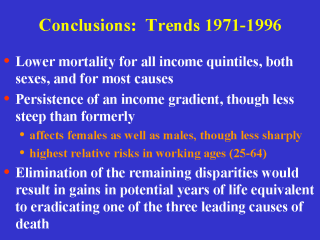| front |1 |2 |3 |4 |5 |6 |7 |8 |9 |10 |11 |12 |13 |14 |15 |16 |17 |18 |19 |20 |21 |22 |23 |24 |25 |26 |review |
 |
The trends from
1971 through 1996 show a general pattern of lower mortality for all income quintiles, for
both sexes and for most causes of death. Throughout this 25-year period, the most common pattern was of an income gradient in mortality where the richest quintile had the lowest mortality and the poorest quintile had the highest. The income gradients generally persisted over time, though the gradient tended to be less steep in recent years, particularly for females. The gradients were seen among females as well as males, although less sharply. By age, the highest relative risks for the poorest quintile compared to the richest were in the prime working ages. Elimination of the remaining disparities would result in gains in potential years of life equivalent to eradicating one of the three leading causes of death. |